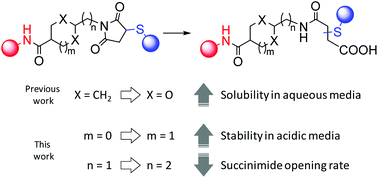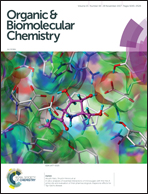Structural investigation of cyclo-dioxo maleimide cross-linkers for acid and serum stability†
Abstract
The biochemical characteristics of hetero-bifunctional cross-linkers used in bioconjugates are of essential importance to the desired features of the final adduct (i.e. antibody–drug conjugates). These include stability in biological media, chemical and biological reactivities, cleavability under defined conditions, and solubility. In our previous work, we introduced a new amino-to-thiol linker, maleimidomethyl dioxane (MD), as an alternative to classical maleimide conjugation, with increased hydrophilicity and serum stability due to succinimidyl ring-opening. In this work, we investigate the generality of linkers containing a dioxo-ring with regard to their ability to self-hydrolyze and their surprising stability at a low pH. We synthesized four FRET probes which allowed us to address the stability of the dioxo-ring and to study the maleimide ring-opening and the thiol-exchange processes by means of detecting and measuring the generation of fluorescence. It was found that the ring expansion (from a 5- to a 6-membered ring) improved the stability of the probes in aqueous media, and the increase of the chain length between the dioxo-ring and the succinimide ring (from methylene to ethylene) decreased the rate of succinimidyl ring-opening.



 Please wait while we load your content...
Please wait while we load your content...